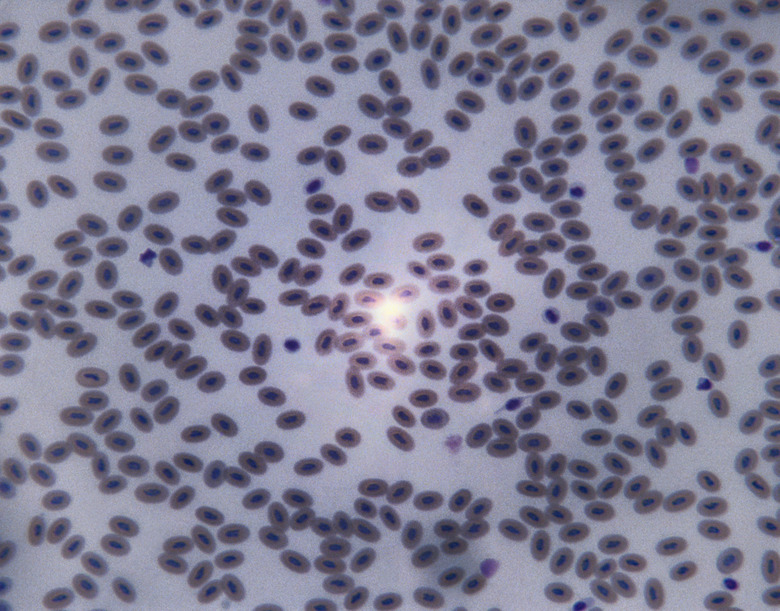What Are The Biomolecules Of Ribosomes?
When you think about cells, you probably picture the roundish blobs you see when you put a slide under a microscope. Or perhaps you recall cell models you built in elementary school, complete with labeled organelles molded from clay.
When you consider cells and organelles a little deeper, such as wondering about the two types of molecule from which a ribosome is made, it brings into clear view the way that the cell's structure determines its function.
TL;DR (Too Long; Didn't Read)
Ribosomes contain two biomolecules: **nucleic acid** and **protein**. This makes sense because the ribosome's job in the cell is to use a nucleic acid template called messenger RNA (mRNA) to build new proteins.
What Are Cells and Biomolecules?
What
Are Cells and Biomolecules?
You probably already know that the cell is the fundamental unit of a living organism. It's enclosed by a cell membrane (and a cell wall in the cases of bacteria, plant and some fungal cells) and eukaryotic cells contain organelles that perform specific jobs in the cell.
Cells act as individual units to break down nutrients for energy, build biomolecules and replicate themselves. In multicellular organisms, such as humans, many individual cells specialize and cooperate to form tissues and organs.
There are four major types of biomolecules that make up the cells of living organisms that are also called the macromolecules of life:
1. carbohydrates 2. lipids 3. proteins 4. nucleic acids
Carbohydrates and lipids store energy in the cell, form structural components and act as chemical messengers. Proteins perform similar roles but also set off the chemical reactions that make life possible and affect gene activity. Nucleic acids store the organism's entire genetic code.
Ribosomes Facts
Ribosomes
Facts
**Ribosomes** are important for all living cells because they build proteins. Depending on the type of cell, any given cell contains between several thousand and a few million ribosomes. Since they are the protein-synthesizing machines of the cell, cells that require lots of proteins simply have more ribosomes.
Ribosomes may attach to another organelle, such as the **rough endoplasmic reticulum** or the nuclear envelope, which surrounds the **nucleus**. Or they may float freely in the cytoplasmic broth of the cell. Most proteins built in free ribosomes remain in the cell whereas the proteins built by ribosomes bound to the endoplasmic reticulum are usually marked for transport out of the cell.
Protein Synthesis
Protein Synthesis
To build proteins, ribosomes rely on instructions from the nucleus, which contains the organism's DNA. The primary function of DNA is to store the genetic blueprint for building biomolecules, such as proteins. Ribosomes receive bits of this blueprint via specialized nucleic acids called messenger RNA (mRNA).
The ribosome uses this mRNA as a template to build long chains of amino acids, supplied to the ribosome by another nucleic acid called transfer RNA (tRNA). Once complete, the chain folds in a specific way, called a conformation. This folded unit is now a functional protein.
Biomolecules in Ribosomes
Biomolecules
in Ribosomes
Knowing that ribosomes synthesize proteins from nucleic acid templates, you can probably guess the two types of molecule from which a ribosome is made. The answer, of course, is proteins and nucleic acids. In fact, ribosomes are approximately 60 percent RNA and 40 percent protein.
Ribosomal proteins and ribosomal RNA (rRNA) together make up the two subunits of the ribosome. Surprisingly, the nucleic acid portion contributes to most of the structure of the ribosome while the proteins fill in gaps and amp up protein synthesis, which would occur much more slowly without them.
The two subunits of the ribosome separate when not building proteins. Scientists describe them based on their sedimentation rates. Most eukaryotic cell ribosomes, including those in human cells, contain a 40s subunit and a 60s subunit.
Cite This Article
MLA
Mayer, Melissa. "What Are The Biomolecules Of Ribosomes?" sciencing.com, https://www.sciencing.com/biomolecules-ribosomes-15739/. 16 April 2019.
APA
Mayer, Melissa. (2019, April 16). What Are The Biomolecules Of Ribosomes?. sciencing.com. Retrieved from https://www.sciencing.com/biomolecules-ribosomes-15739/
Chicago
Mayer, Melissa. What Are The Biomolecules Of Ribosomes? last modified March 24, 2022. https://www.sciencing.com/biomolecules-ribosomes-15739/
